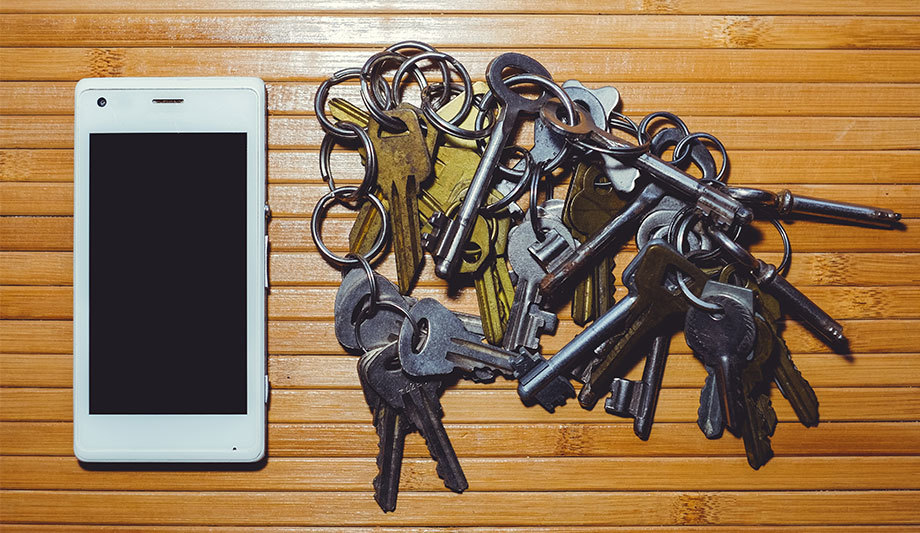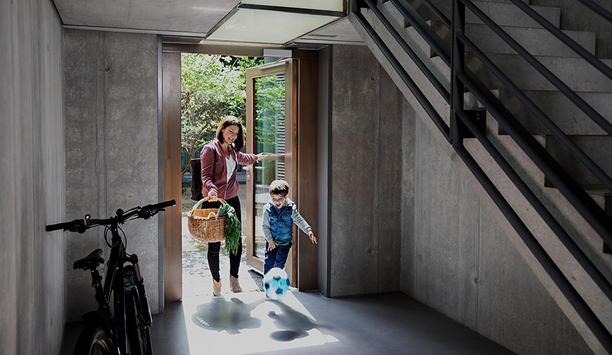How’s this for a simple access control scenario? You walk up to a door, wave your hand in front of a button, the button lights up, and the door opens. That’s the simplified user experience that startup Openpath is promoting as it enters the crowded and mature market for physical access control.
Openpath says a simple user experience provides the extra boost needed for mobile credentialing to gain momentum. In this case, it’s even simpler than using a card credential (no searching in a bag or purse for the card). And there’s no personal identification number (PIN) code to remember; no “intrusive” biometric element that can concern some users. James Segil, President and Co-Founder of Openpath, says the simplified process “uses fewer thought cycles.”
Reliability of the system comes from Openpath’s SurePath triple-connect technology
“We wanted to make mobile access control that people want to use and can use safely and with ease,” he says. “We wanted to make using a smart phone for access control easier and more reliable than using a keycard.”
Simplified user operation
In the simplified scenario, the mobile credential resides on a smart phone that can remain tucked away in the user’s purse or pocket. The credential remains active without the user needing to open an app. The wave of the hand signals intent, which causes the button to light up, activate and the door is ready to open. Segil says the simplicity of operation has contributed to the system seeing an unheard-of 94% adoption rate among users.
Reliability of the system comes from Openpath’s SurePath triple-connect technology. The smart phone credential is delivered using Bluetooth, WiFi or LTE (cellular) – whichever signal reaches the reader first enables the door to be opened. So even if a company’s WiFi is down or Bluetooth proves unreliable, there is still a third option.
 |
| Openpath deploys “seamless” cloud integration and makes it easy for landlords and tenants to integrate Openpath with other systems |
Seamless cloud integration
Segil is a serial entrepreneur who has had experiences as a frustrated user, dealing with many different offices, people and access control deployments over the years – subletting office space, changing PIN codes, dealing with 10 different offices using 10 different cards. Based on that experience, Openpath’s founders saw a need for a more user-centric approach to access control, and a chance to improve the office experience to be more aligned with employees’ experiences in their smart homes.
Segil says he also saw “significant lethargy” among incumbent players in the access control space, and a market in which mobile and cloud technologies had still not taken hold. In addition to a simplified user experience built around mobile credentialing, Openpath deploys “seamless” cloud integration and makes it easy for landlords and tenants to integrate Openpath with other systems. The “elegant” readers, including a flush-mounted version, fit in well with high-end office environments. The company launched in May 2018.
Openpath has been signing up national and regional channel partners all across the U.S.
Openpath is focused on the commercial real estate market, where they have already seen significant adoptions, especially among mid-sized companies. Larger deployments as part of new construction are in the pipeline.
National system integration
In the past six months since its launch, Openpath has been signing up national and regional channel partners all across the U.S. and now has a nationwide footprint and is able to service customers all over the U.S. They are not yet disclosing any specifics about the number of partners they have signed up and who they are. “I can share that we have a number of large national system integration and security brands on board as channel partners and many more regional and local system integrators,” says Segil. They are looking for additional integrator partners. “There is a cohort of folks out there who say ‘I get it,’ and I want to offer it to my customers,” says Segil. The cloud element of the system can provide recurring monthly revenue (RMR).
Openpath’s system offers flexibility in terms of meeting each customer’s security needs. In addition to the “super convenient” scenario described above, the system can also be configured to be “super secure,” using two-factor authentication and other measures, says Segil. There are multiple “flavors” between the two extremes. It can also be integrated with elevators to enable the buttons on allowed floors.
Integration with existing systems
Cloud software simplifies operation for both tenants and landlords. The system is backwards-compatible to existing systems and can be used to retrofit and mobile-enable a legacy system, providing the benefits of mobile features and cloud operation to multiple sites. The software can interface with enterprise applications such as Active Directory, and an application programming interface (API) facilitates integration with other systems and building components. It operates with marketing automation platforms such as Flack and visitor management systems such as Envoy.
 |
| The system is backwards-compatible, providing the benefits of mobile features and cloud operation to multiple sites |
Open standards make the system easy to install in new or existing buildings using RS485, or Cat 5 or Cat 6 wiring, whatever is in place. Retrofit installations can use existing panels, servers, software, etc., or they can be replaced. The Openpath panel is installed right next to an existing panel in a retrofit and preserves all legacy integrations of the previous system.
Access credentials compatibility
In its simplest configuration, the Openpath system consists of single or four-door panels wired using standard ports, Wiegand ports and REX ports, each connected to software in the cloud. Each panel works offline if the internet connection is down. Various key fobs, cards and other credentials are available in addition to mobile credentials.
Openpath was one of the new exhibitors at last fall’s GSX show in Las Vegas, occupying a large-sized booth for a startup company. The “beautiful” hardware drew a lot of attention, says Segil. “The channel loves us, and we signed a lot of people,” he adds. “We were excited by the response.”








